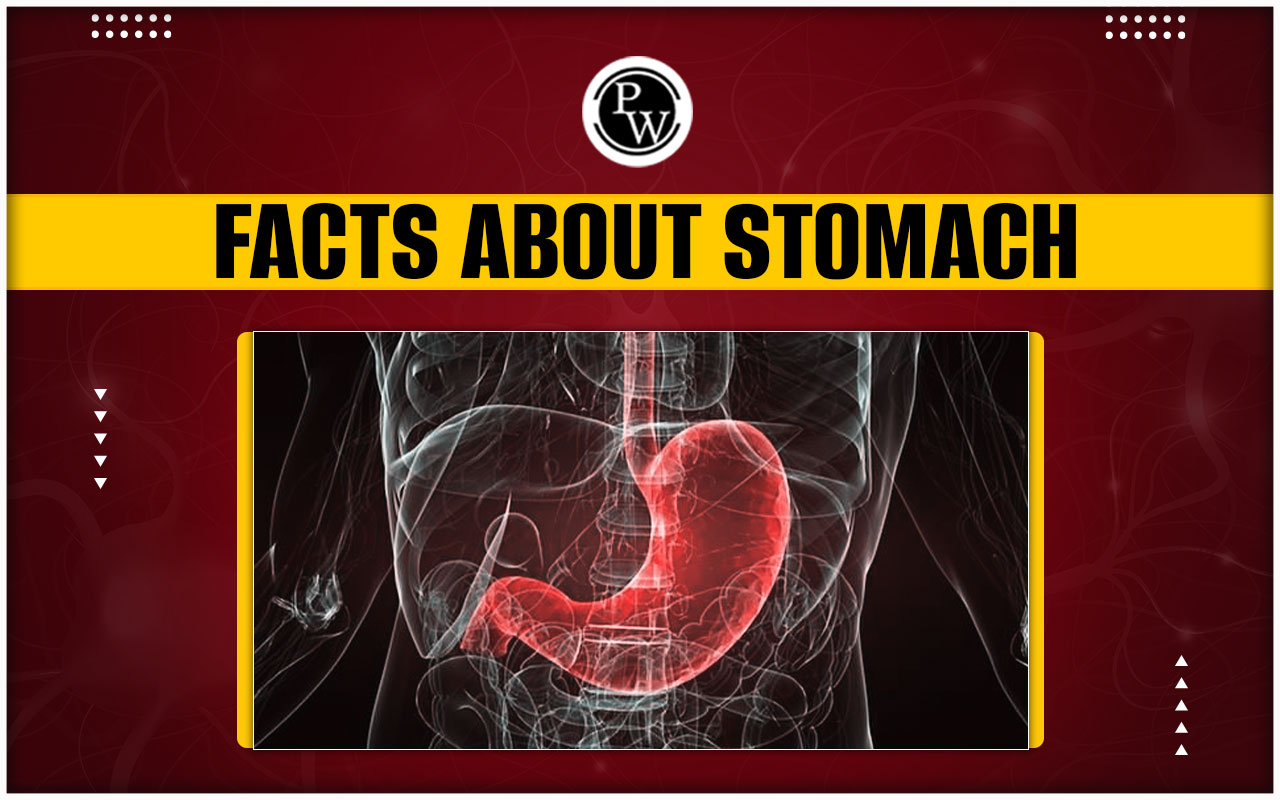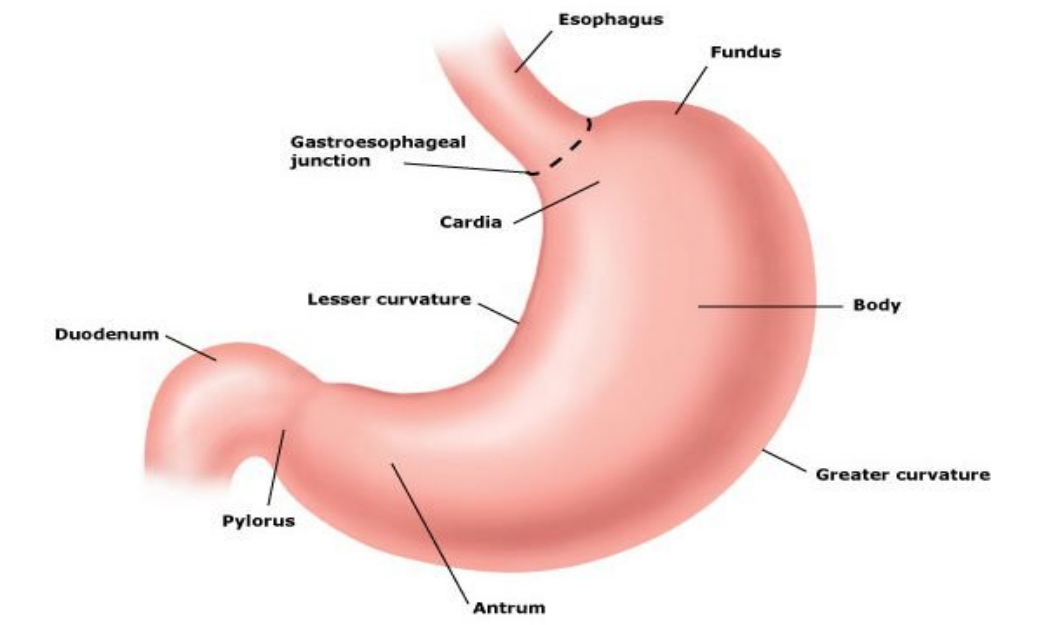

You have reached the proper destination if you were looking for information on the Facts About Stomach . This article comprehensively describes interesting facts about the stomach, covering from Stomach anatomy to functions and disorders. People pressed for time should read as much of the article as possible, even if it's just the paragraph that introduces the topic and the important topics. This is the very minimum of the stuff that has to be read.
Introduction
The stomach is a muscular organ found in the upper portion of the abdominal cavity. Combining food with digestive fluids and grinding it into a chyme liquid is essential to the digestive system. The stomach plays an important function in the process. The chyme is secreted from the stomach into the small intestine, where most of the food's vitamins, minerals, and other beneficial components are absorbed into circulation. Additionally, the stomach secretes hormones that regulate appetite and the digestive process, as well as acids and enzymes that assist in breaking down food.Facts About Stomach Anatomy
Fact 1
Stomach is a muscular organ between the oesophagus and the small intestine.Fact 2
Stomach has the appearance of the letter J, with a curved bottom and an entrance known as the pylorus at the structure's base.Fact 3
Adults have stomachs around the size of a closed fist.Fact 4
The mucosa, located on the inside surface of the stomach, is home to millions of minuscule glands responsible for the production of digesting enzymes.Fact 5
The muscular walls of the stomach flex and relax to combine food with digestive fluids, forming a viscous liquid known as chyme.
Fact 6
The stomach can expand to make room for huge meals, but it often contracts back to its normal size within a few hours after eating.Fact 7
The stomach secretes a substantial layer of mucus, a barrier between the acidic digestive fluids and the stomach lining.Fact 8
The lower oesophagal sphincter (LES) is a sphincter muscle at the top of the stomach. It opens to enable food to enter the stomach and shuts to prevent stomach acid from running back up into the oesophagus.Fact 9
The pyloric sphincter is a sphincter muscle located at the bottom of the stomach. It relaxes to enable chyme to pass into the small intestine when the stomach is empty.Fact 10
The gastric arteries are branches that originate from the celiac artery and deliver blood to the stomach.Fact 11
The vagus nerve, located in the stomach and a member of the parasympathetic nervous system, is responsible for stimulating the production of gastric juices.Fact 12
Stomach is encircled by several other organs, including the liver, the pancreas, and the spleen.Environmental Issues and Solutions
Facts on Stomach Functions
Fact 13
The major job of the stomach is to cut up ingested material into more manageable bits and combine it with digestive secretions to start the digestive process.Fact 14
The stomach has a capacity of up to 2.5 litres, which includes both food and fluids.Fact 15
Pepsin and hydrochloric acid, which are secreted by the stomach, are important for digestion that breaks down proteins.Fact 16
A hormone known as gastrin is also produced by the stomach. Gastrin encourages the production of gastric fluids and speeds up food movement through the stomach.Fact 17
Although the stomach absorbs some nutrients, such as alcohol and some medications, the small intestine is responsible for most nutritional absorption.Fact 18
Ghrelin is a hormone produced in the stomach that sends the brain a message that one is hungry.Fact 19
Stomach releases a hormone known as leptin, which sends a message to the brain when it is full.Fact 20
It may take the small intestine up to four hours to receive the contents stored in the stomach.Fact 21
The stomach can also regulate the release of food into the small intestine based on the size of the food item, the number of nutrients it contains, and the rate at which digestion occurs.Fact 22
During mechanical digestion, which includes contractions of the muscle walls and grinding of the stomach's contents, the stomach can break down food into smaller and smaller bits.Fact 23
Chemical digestion of food can also take place in the stomach with the help of digestive enzymes like pepsin and lipase.Fact 24
Because alcohol and other drugs may be absorbed directly into the bloodstream via the stomach lining, absorption of these substances also involves the stomach, which plays a part in the process.Fact 25
The release of hormones such as insulin and glucagon from the stomach is another way the stomach contributes to regulating sugar levels in the blood.Fact 26
The stomach plays a part in the immunisation process.Facts on Stomach Disorders
Fact 27
In the United States, up to twenty per cent of the population suffers from gastroesophageal reflux disease, often known as GERD.Fact 28
The bacteria Helicobacter pylori and the usage of nonsteroidal anti-inflammatory drugs (NSAIDs) are the most prevalent causes of peptic ulcers.Fact 29
Inflammatory bowel disorders like Crohn's disease and ulcerative colitis, which can damage the stomach and cause symptoms like nausea, vomiting, and abdominal discomfort, are classified as inflammatory bowel diseases.Fact 30
Celiac disease is an autoimmune condition that mostly impacts the small intestine, but it also has the potential to cause abdominal discomfort, bloating, and other digestive problems.Fact 31
The stomach flu, or gastroenteritis, is a common ailment caused by viruses, bacteria, or parasites. It is also known as stomach flu.Fact 32
Cancer of the stomach is the third most prevalent cause of death from cancer among people all over the world.Fact 33
Irritable bowel syndrome (IBS) is a common illness that can include stomach discomfort, bloating, and changes in bowel habits. IBS is an abbreviation for the medical term irritable bowel syndrome.Fact 34
A disorder known as gastroparesis causes the stomach to empty its contents more slowly than normal. Symptoms of gastroparesis include nausea, vomiting, and abdominal discomfort.Fact 35
Achalasia is an extremely uncommon condition that affects the oesophagus and can result in difficulties swallowing as well as the regurgitation of food.Fact 36
Conditions such as peptic ulcers, oesophagal varices, and inflammatory bowel disease can all be the root cause of bleeding in the gastrointestinal tract. This bleeding can occur in the stomach or other regions of the digestive system.Fact 37
Peptic ulcers and other symptoms can be brought on by a rare ailment known as Zollinger-Ellison syndrome. This condition occurs when the pancreas or duodenum tumours cause the stomach to generate an abnormally high amount of acid.Fact 38
In the disease of gastroduodenal obstruction, either the stomach or the duodenum becomes blocked. This is typically caused by a tumour and can result in nausea, vomiting, and abdominal discomfort.Fact 39
Infections of the stomach can be brought on by bacteria like Helicobacter pylori or by viruses like norovirus.Fact 40
Stomach discomfort, bloating, and diarrhoea are just some of the symptoms brought on by a food allergy or intolerance.Fact 41
Depending on the underlying cause of the problem and the degree of severity, stomach issues are often treatable by modifying one's diet, taking medicine, or undergoing surgery.Related Links -
Stomach <span style=
Q1. What are the causes of gastritis?
Ans- Gastritis can be caused by several things, such as an injury, an infection, or nonsteroidal anti-inflammatory medicines (NSAIDs).
Q2. What is gastroparesis?
Ans- Gastroparesis is a disorder in which the stomach muscles cease functioning properly. This results in sluggish digestion and a sensation of fullness after consuming just a small amount of food, which can be caused by gastroparesis.
Q3. How do doctors identify stomach disorders?
Ans- A stomach issue can be diagnosed by doing a series of tests, including an endoscopy, a biopsy, and X-rays, as well as conducting a physical exam and reviewing the patient's medical history.
Q4. What foods are easier for the stomach to break down into smaller parts?
Ans- Sugar and bread are simple carbohydrates that typically have the quickest digestion times. This is because they are rapidly metabolised into glucose and taken into circulation in a short amount of time. In addition to the health of the digestive tract, the presence of fibre, fat, and protein in the food can also have a role in the rate at which digestion occurs.
Q5. What are the underlying factors that lead to infections in the stomach causing ulcers?
Ans- The bacteria Helicobacter pylori is often the reason for stomach ulcers caused by infections.
Q6. What is IBS?
Ans- Irritable bowel syndrome, sometimes known as IBS, is an illness that affects the large intestine and can produce various gastrointestinal symptoms, including stomach discomfort, bloating, constipation, and diarrhoea.
🔥 Trending Blogs
Talk to a counsellorHave doubts? Our support team will be happy to assist you!

Free Learning Resources
PW Books
Notes (Class 10-12)
PW Study Materials
Notes (Class 6-9)
Ncert Solutions
Govt Exams
Class 6th to 12th Online Courses
Govt Job Exams Courses
UPSC Coaching
Defence Exam Coaching
Gate Exam Coaching
Other Exams
Know about Physics Wallah
Physics Wallah is an Indian edtech platform that provides accessible & comprehensive learning experiences to students from Class 6th to postgraduate level. We also provide extensive NCERT solutions, sample paper, NEET, JEE Mains, BITSAT previous year papers & more such resources to students. Physics Wallah also caters to over 3.5 million registered students and over 78 lakh+ Youtube subscribers with 4.8 rating on its app.
We Stand Out because
We provide students with intensive courses with India’s qualified & experienced faculties & mentors. PW strives to make the learning experience comprehensive and accessible for students of all sections of society. We believe in empowering every single student who couldn't dream of a good career in engineering and medical field earlier.
Our Key Focus Areas
Physics Wallah's main focus is to make the learning experience as economical as possible for all students. With our affordable courses like Lakshya, Udaan and Arjuna and many others, we have been able to provide a platform for lakhs of aspirants. From providing Chemistry, Maths, Physics formula to giving e-books of eminent authors like RD Sharma, RS Aggarwal and Lakhmir Singh, PW focuses on every single student's need for preparation.
What Makes Us Different
Physics Wallah strives to develop a comprehensive pedagogical structure for students, where they get a state-of-the-art learning experience with study material and resources. Apart from catering students preparing for JEE Mains and NEET, PW also provides study material for each state board like Uttar Pradesh, Bihar, and others
Copyright © 2025 Physicswallah Limited All rights reserved.
Get App











